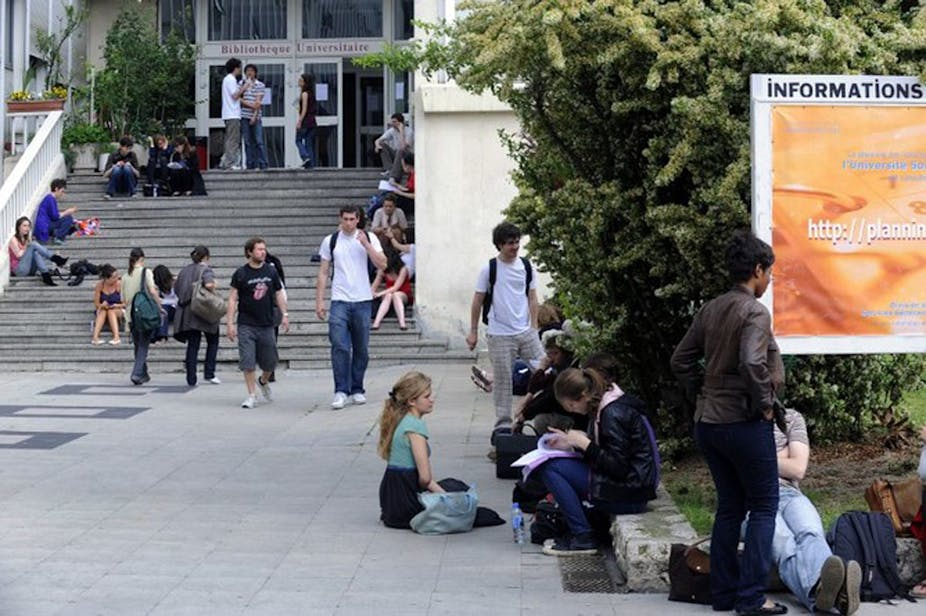The Conversation’s international teams are collaborating on a series of articles about the Globalisation of Higher Education, examining how universities are changing in an increasingly globalised world. Read more here.
In his 1975 novel Changing Places, British novelist David Lodge satirised the lifestyle of two literature professors who crisscross the planet, trading a rainy English campus for a sunny California university, and vice versa. Along the way, many other things are exchanged as well, including affairs of the heart.
While scholars working today don’t enjoy the same benefits – luxury hotels and business-class flights, in particular – they might recognise that they still live in Lodge’s small world. Since the mid-1970s, transportation and communication advances have made the planet steadily smaller and the number of international students has soared in turn. In Lodge’s novels, universities seemed changeless, while four decades later they are fully engaged in internationalisation.
In the post-Cold War era, academic relationships are becoming richer and more complex. Students in the Global South, eager to participate in the knowledge economy – and receive some of its benefits – are driving much of the increased demand for education at all levels. That future profits and solutions to pressing global problems are to be found in advanced research makes international collaboration indispensable.
As a recent report from the European University Association shows, internationalisation is a strategic priority for many universities and they’re working to put themselves on the world map. When striking out for new lands, however, familiar rules no longer apply and new guidelines must be established to increase the chance of profits, or at least minimise potential losses.
Red herrings
Whatever the size of the university, narratives about making students “global citizens” are becoming more commonplace. What this precisely means is unclear, making it indispensable for us to better understand these narratives, the associated strategies, and so some misleading assumptions on which they are grounded.
The first of these red herrings is the idea that higher-education institutions are part of a homogeneous universe, whose members are equivalent to each other – that they provide the same kind of service (education), perform similar activities (teaching, publishing research), and all call themselves universities. World rankings reinforce this idea, and while much can be said about them, the most important point is that they fail to recognise diversity. Universities can have a wide range of structures, objectives and funding schemes, in addition to an innumerable number of other differences. They are not like hotels that can be rated with stars to help travellers looking for accommodations.
The second misleading assumption stems from this faulty notion of a flat academic world. Universities and other higher-education institutions have entered the realm of “best practices”, an ideology that began to spread several decades ago in business and then local government. There might be, for example, new ways of financing research, promoting the dissemination of results, improving campus life, or creating alumni networks. While this is laudable in theory, in international academic gatherings one is often struck by the fact that everyone seems to do the same thing at the same time.
Some critics have pointed out that such “best practices” are often justified by efficiency alone, with little regard for their social and political meanings or implications. Although universities can certainly learn a lot from each other, each one should devise its strategy and choose its course in accordance with its identity, means and expectations of its students and staff. To endlessly replicate “successful models” is not advisable.
Rule of marteloio

In the mid-1400s, when sailors had no instruments to determine their position with accuracy, they used a navigational technique known as the rule of marteloio to determine routes from harbour to harbour. Today, similar routes are being drawn between universities, creating global networks. Some are venerable, such as the Pontifical universities of the Roman Catholic Church, while others are newer, including the Worldwide Universities Network, with its strong emphasis on research. Others are commercial, like Laureate International Universities, a group that claims almost 90 member institutions.
As with all networks, they can be instruments of inclusion as well as exclusion. Global universities are recognisable because they belong to or lead global networks, while smaller institutions from less visible countries strive to become members of these clubs. Although some major networks include partners from developing countries, there is still a huge gap in terms of participation between North and South.
Treasure islands
The internationalisation of universities raises an old problem: the ability to connect to global dynamics without losing diversity. Some aspects of global science, such as Nobel prizes, tend to promote a “winner-takes-all” system. Higher education institutions should take a critical distance from this tendency and embrace their diversity – there is more than one Treasure Island for science. Internationalisation is not about going to places similar to our own country or institution. Instead, students and scholars can find stimulating environments and academic conditions that can challenge what they take for granted.
We generally assume that higher education and innovation go hand in hand, but we do not know how innovation comes about. Research is often devoted to dissemination, financing, or public policy, but there is less evidence on why an innovation occurs. The only reasonable assumption is that it happens in adverse conditions, when we have to overcome a problem. That’s why it’s important to put students and scholars in challenging, diverse situations and help them learn different ways of thinking. From my point of view, facilitating access and promoting diversity should be the compass of all internationalisation strategies. So, anchors aweigh, and let’s sail.
This article was originally published in French.

